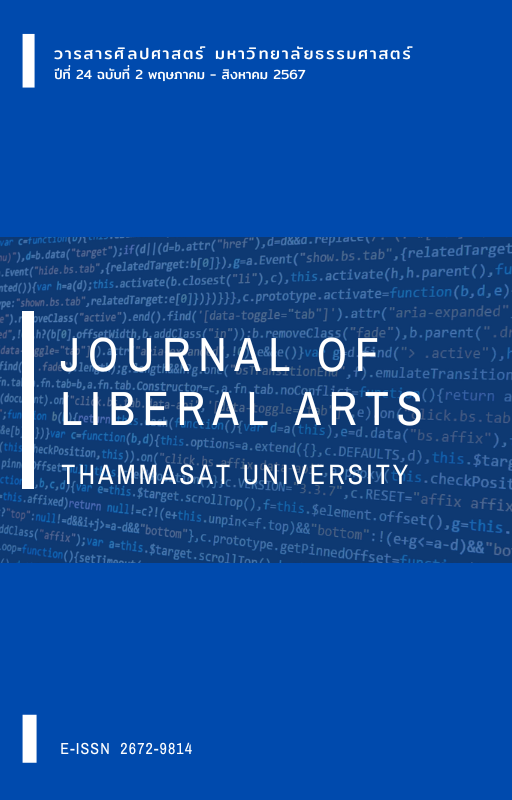The Meaning and Translation of “Tao” (道) to Thai: A Case Study of Taoism Scripture Translation by Pakorn Limpanusorn
Main Article Content
Abstract
The purpose of this paper is to explore meanings and translation techniques of the word “Tao” (道) from the original Chinese text to Thai and in addition to analyze cultural factors which affect the translation by examining three books of Taoism philosophers, namely Lao Tzu, Zhuang Zhou, and Lei Zi as well as related documents. For Thai translation, this paper examines the works of Pakorn Limpanusorn because he has translated all three Taoism scriptures from the original language. The result shows that there are many meanings of “Tao” translated from Chinese to Thai and the translation of the Taoism work of Lei Zi shows the greatest variation. The research found six methods of translation: 1) Transcription, 2) Literal Translation, 3) Opting for a word in the original language which is similar to or has the same “relevance” as the original language term, 4) Translation by a more general word superordinate, 5) Translation by using more than one translation strategy, and 6) Simile. Nevertheless, cultural factors which involve religious beliefs are the main factors that strongly impacted the translation of these three scriptures. The translator uses Buddhist terms to translate “Tao”, both directly and indirectly, reflecting the relationship of Taoism and Buddhist philosophy evident in the Thai translation.
Downloads
Article Details

This work is licensed under a Creative Commons Attribution-NonCommercial-NoDerivatives 4.0 International License.
References
กนกพร นุ่มทอง. (2554). ตำราการแปลภาษาไทยเป็นภาษาจีน (พิมพ์ครั้งที่ 2). สถาบันขงจื๊อ มหาวิทยาลัยเกษตรศาสตร์.
กนกพร นุ่มทอง. (2563). ทักษะการแปลภาษาจีนเป็นภาษาจีน. มหาวิทยาลัยเกษตรศาสตร์, คณะมนุษศาสตร์, ภาควิชาภาษาตะวันออก.
กนกพร นุ่มทอง. (2564). การศึกษาปัญหาและกลวิธีการแปลภาษาจากเอกสารประวัติศาสตร์ภาษาจีนเป็นภาษาไทย. วารสารภาษาและภาษาศาสตร์, 39(2), 31-50.
กนกพร นุ่มทอง และ ศิริวรรณ ลิขิตเจริญธรรม. (2562). หลักและข้อควรระวัง ในการแปลจีน-ไทย ไทย-จีน. วารสารจีนศึกษา มหาวิทยาลัยเกษตรศาสตร์, 12(2), 105-151.
กรมการศาสนา. (2525). พระไตรปิฎกฉบับหลวง (๔๕ เล่ม). กรมการศาสนา.
จันทิมา อังคพณิชกิจ. (2562). การวิเคราะห์ข้อความ (พิมพ์ครั้งที่ 2). สำนักพิมพ์มหาวิทยาลัย ธรรมศาสตร์.
ปกรณ์ ลิมปนุสรณ์. (2547). คัมภีร์เต๋าของเหลาจื่อ. สร้างสรรค์บุ๊คส์.
ปกรณ์ ลิมปนุสรณ์. (2548). คัมภีร์เต๋าของจวงจื่อ. สร้างสรรค์บุ๊คส์.
ปกรณ์ ลิมปนุสรณ์. (2545). คัมภีร์เต๋าของเลี่ยจื่อ. สร้างสรรค์บุ๊คส์.
ธัญญรัตน์ ปาณะกุล. (2563). นักแปลกับปัญหาการแปลข้ามวัฒนธรรม. วารสารมนุษยศาสตร์ฉบับบัณฑิตศึกษา, 9(1), 60-71.
พนมกร คำวัง. (2562). ความเป็นมาและพัฒนาการของลัทธิเต๋า. วารสารวิจัยธรรมศึกษา. วารสารวิจัยธรรมศึกษา ศูนย์วิจัยธรรมศึกษา สำนักเรียนวัดอาวุธวิกสิตาราม, 2(2), 25-39.
พระพรหมคุณาภรณ์ (ป.อ. ปยุตฺโต). (2554). พจนานุกรมพุทธศาสน์ ฉบับประมวลศัพท์. สหธรรมิก.
ราชบัณฑิตยสถาน. (2556). พจนานุกรม ฉบับราชบัณฑิตยสถาน พ.ศ. 2554. นานมีบุ๊คส์พับลิเคชั่นส์.
สัญฉวี สายบัว. (2542). หลักการแปล (พิมพ์ครั้งที่ 7). มหาวิทยาลัยธรรมศาสตร์.
สุพรรณี ปิ่นมณี. (2562). แปลผิด แปลถูก: คัมภีร์การแปลยุคใหม่. สำนักพิมพ์แห่งจุฬาลงกรณ์มหาวิทยาลัย.
อธิศา งามศรี. (2560). กลวิธีการแปลคำและวลีทางวัฒนธรรมที่พบในบทแปลจากภาษาไทยเป็นภาษาอังกฤษ กรณีศึกษาหนังสือเรื่อง “ครูบ้านนอก” โดย คำหมาน คนไค [วิทยานิพนธ์ปริญญามหาบัณฑิต]. มหาวิทยาลัยธรรมศาสตร์.
Newmark, P. (1988). A textbook of translation. Prentice Hall International (UK) Ltd.
Nida, E. A., & Taber, C. R. (1982). The theory and practice of translation (2nd photomechanical reprint). The United Bible Societies.
Merriam-Webster. (n.d.). Tao. In Merriam-Webster.com dictionary. Retrieved March 5, 2022, form https://www.merriam-webster.com/dictionary/Tao
Wang, Y. (2017). Translation ancient Chinese poems by applying interpretive translation. Chinese Studies, 6(1), 29-36.
Chen Fuhua陈复华著《古代汉语词典》编写组编. (2002).《古代汉语词典》(大字本). 商务印书馆出版社.
Chen Guying陈鼓应. (1988). 老子註译及评介. 中华书局出.
Dong Binbin董斌斌. (2013). 道可道,非常道 ——《道德经》中 “道” 字翻译的研究 .大学教育, (07), 152-154.
Ding Yi丁一. (2018).《庄子》智慧全解. 华中科技大学出社.
Lian Peipei, & Cai Panke连佩佩, 蔡攀科. (2011). 从零翻译的角度看《道德经》中 “道” 字的翻译. 语言文字, (09), 108-109.
Liu Kongxi, & Yang Bingjun刘孔喜, 杨炳钧. (2015). 翻译原型论视角的老子哲学术语英译研究 ———以名词 “道” 译作 way的理据为例 . 语言文字, 36(01), 102-107.
Liu Qianyang刘乾阳. (2013). 跨文化视角下《庄子》“道” 的英译. 山东大学.
Lu Shuxiang, & Ding Shengshu吕叔湘, 丁声树. (2016). 现代汉语词典. 商务印书馆出版社.
Wang Libo王力波. (2018). 《列子译注》. 黑龙江人民出版社.
Yang Jieqing杨洁清. (2011). 译 “道 ” 之道———基于语料库的《道德经》“道” 字翻译研究. 周口师范学院学报, 28(03), 68-71

